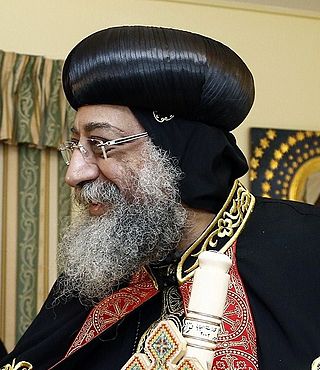Related Research Articles
Eutyches or Eutyches of Constantinople was a presbyter and archimandrite at Constantinople. He first came to notice in 431 at the First Council of Ephesus, for his vehement opposition to the teachings of Nestorius. At the 448 Synod of Constantinople and the 451 Council of Chalcedon, Eutyches was condemned for having adopted an equally extreme, although opposite view. He himself, however, would reject this interpretation of his thought.

Menas, considered a saint in the Calcedonian affirming church and by extension both the Eastern Orthodox Church and Roman Catholic Church of our times, was born in Alexandria, and enters the records in high ecclesiastical office as presbyter and director of the Hospital of Sampson in Constantinople, where tradition has him linked to Saint Sampson directly, and in the healing of Justinian from the bubonic plague in 542. He was appointed Patriarch of Constantinople by the Byzantine emperor Justinian I on 13 March 536. Pope Agapetus I consecrated him to succeed Anthimus, who was condemned as a monophysite. This was the first time that a Roman Pope consecrated a Patriarch of Constantinople.
Jacob Baradaeus, also known as Jacob bar Addai or Jacob bar Theophilus, was the Bishop of Edessa from 543/544 until his death in 578. He is venerated as a saint in the Oriental Orthodox Churches and his feast day is 31 July. Jacob's missionary efforts helped establish the non-Chalcedonian Syriac Orthodox Church, also known as the "Jacobite" Church after its eponymous leader, and ensured its survival despite persecution.
The Patriarch of Antioch is a traditional title held by the bishop of Antioch. As the traditional "overseer" of the first gentile Christian community, the position has been of prime importance in Pauline Christianity from its earliest period. This diocese is one of the few for which the names of its bishops from the apostolic beginnings have been preserved. Today five churches use the title of patriarch of Antioch: one Oriental Orthodox ; three Eastern Catholic ; and one Eastern Orthodox.

Severus the Great of Antioch, also known as Severus of Gaza or the Crown of Syrians, was the Patriarch of Antioch, and head of the Syriac Orthodox Church, from 512 until his death in 538. He is venerated as a saint in the Oriental Orthodox Church, and his feast day is 8 February.
The Henotikon was a christological document issued by Byzantine emperor Zeno in 482, in an unsuccessful attempt to reconcile the differences between the supporters of the Council of Chalcedon and the council's opponents. It was followed by the Acacian schism.

Pope Timothy II of Alexandria, also known as Timothy Ailuros, succeeded twice in supplanting the Chalcedonian patriarch of Alexandria.
Pope Peter III of Alexandria also known as Peter Mongus was the 27th Pope of Alexandria and Patriarch of the See of St. Mark.

The pope, also known as the Bishop of Alexandria or the Coptic pope, is the leader of the Coptic Orthodox Church, with ancient Christian roots in Egypt. The primacy in the Coptic pope, similar to the Catholic belief in the Bishop of Rome as successor to Saint Peter, is rooted in his role as successor to Saint Mark. The current holder of this position is Pope Tawadros II, who was selected as the 118th pope on November 18, 2012.
Cyrus of Alexandria was a prominent figure in the 7th century. He served as a Melchite patriarch of the Alexandria diocese and held the position of the last Byzantine prefect of Egypt. Notably, he played a significant role in the development of monothelitism. Cyrus died in Alexandria on March 21, 642.
Pope Theodosius I of Alexandria was the last Patriarch of Alexandria recognised by both Copts and Melchites.

Coptic history is the part of the history of Egypt that begins with the introduction of Christianity in Egypt in the 1st century AD during the Roman period, and covers the history of the Copts to the present day. Many of the historic items related to Coptic Christianity are on display in many museums around the world and a large number is in the Coptic Museum in Coptic Cairo.
Saint Ephraim of Antioch, also known as Saint Ephraim of Amida, was the Patriarch of Antioch, and head of the Chalcedonian Patriarchate of Antioch, from 527 until his death in 545. He is venerated as a saint in the Eastern Orthodox and Catholic Churches. His feast day is 8 June.
The Enaton was a monastic district in Egypt during the Middle Ages. It lasted into the 15th century, but it was at its height between the 5th and 7th centuries. It takes its name, which means "ninth", from its location at the ninth milestone southwest of Alexandria along the coastal road.

The Syriac Orthodox Patriarch of Antiochܦܛܪܝܪܟܐ ܕܐܢܛܝܘܟܝܐ is the Bishop of Antioch, and head of the Syriac Orthodox Church. He is the Head of the Holy Synod of the Syriac Orthodox Church, the highest authority of the Syriac Orthodox Church.
The Gaianites were a Julianist faction within the Egyptian miaphysite church between the sixth and ninth centuries.
Zoora was a Syrian Miaphysite monk and stylite in the Roman Empire. He moved to Constantinople in the early 530s and was condemned at the Council of Constantinople in 536. He died a few years later.
The Council of Constantinople was a conference of the endemic synod held in Constantinople, the capital of the Eastern Roman Empire, in May–June 536. It confirmed the deposition of the Patriarch Anthimus I of Constantinople and condemned three prominent anti-Chalcedonians living in Constantinople, causing the Emperor Justinian I to ban all four from the capital. The Council of Jerusalem held in September was convoked to condemn the same four as heretics. The condemned were the deposed Patriarch Severus of Antioch, the deposed Bishop Peter of Apamea and the monk Zoora.
References
- "Paul (537–542)". Official web site of the Greek Orthodox Patriarchate of Alexandria and All Africa. Retrieved 2011-02-07.